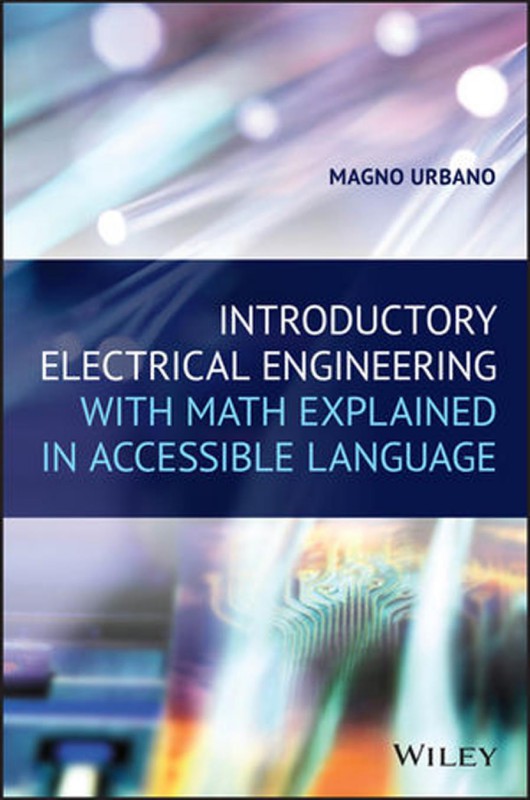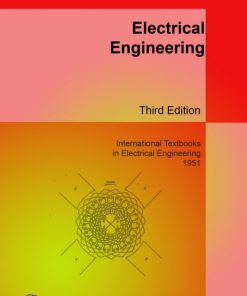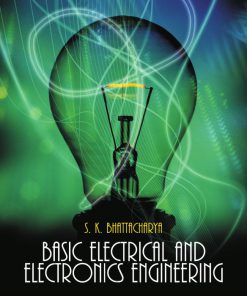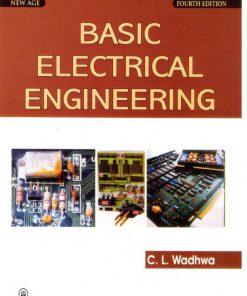(Ebook PDF) Introductory Electrical Engineering With Math Explained in Accessible Language 1st edition by Magno Urbano 111958020X 9781119580201 full chapters
$50.00 Original price was: $50.00.$25.00Current price is: $25.00.
Authors:Magno Urbano , Series:Electrical Engineering [184] , Author sort:Urbano, Magno , Languages:Languages:eng , Published:Published:Nov 2019 , Publisher:Wiley
Introductory Electrical Engineering With Math Explained in Accessible Language 1st edition by Magno Urbano – Ebook PDF Instant Download/DeliveryISBN: 111958020X, 9781119580201
Full download Introductory Electrical Engineering With Math Explained in Accessible Language 1st edition after payment.
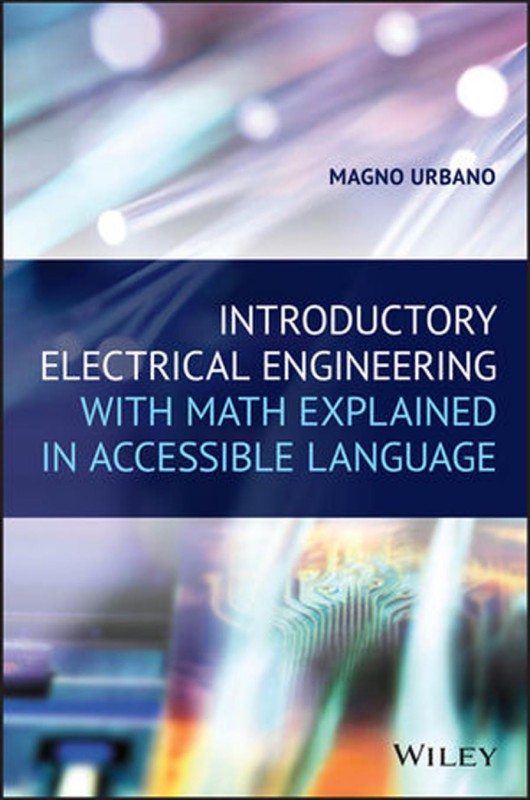
Product details:
ISBN-10 : 111958020X
ISBN-13 : 9781119580201
Author : Magno Urbano
Introductory Electrical Engineering With Math Explained in Accessible Language offers a text that explores the basic concepts and principles of electrical engineering. The author–a noted expert on the topic–explains the underlying mathematics involved in electrical engineering through the use of examples that help with an understanding of the theory. The text contains clear explanations of the mathematical theory that is needed to understand every topic presented, which will aid students in engineering courses who may lack the necessary basic math knowledge.
Introductory Electrical Engineering With Math Explained in Accessible Language 1st Table of contents:
1 Knowledge is Everything
Conventions
1 Introduction
2 Equations
3 Electric Schematics
4 Mathematical Concepts
5 Examples and Exercises
1 Scientific Method
1.1 Introduction
1.2 Powers of 10
1.3 Roots
1.4 Scientific Notation as a Tool
2 Infinitesimal Calculus
2.1 Introduction
2.2 The Concept Behind Calculus
3 Atom
3.1 Introduction
3.2 Atoms and Quarks
3.3 Electrons
3.4 Strong Force and Weak Force
3.5 Conductors and Electricity
3.6 The Shells
3.7 Electric Potential
3.8 Current
3.9 Electric Resistance
4 Voltage and Current
4.1 Introduction
4.2 Terminology
4.3 Batteries
4.4 Danger Will Robison, Danger!
4.5 Direct Current
4.6 Relative Voltages
4.7 Ground
4.8 Alternating Current
Solutions
5 Resistors
5.1 Introduction
5.2 Resistor
5.3 Electric Resistance
5.4 Symbols
5.5 Types of Resistor
5.6 Power
5.7 Color Code
5.8 Potentiometer
5.9 Trimpots
5.10 Practical Usage
5.11 Electric Characteristics
5.12 Resistors in Series
5.13 Resistors in Parallel
5.14 DC and AC Analysis
5.15 Input and Output Synchronism
Solutions
6 Ohm’s Laws
6.1 Introduction
6.2 Basic Rules of Electricity
6.3 First Ohm’s Law
6.4 Second Ohm’s Law
6.5 Examples
Solutions
7 Delta–Wye Conversions
7.1 Introduction
7.2 Delta Circuit
7.3 Delta–Wye Conversion
7.4 Wye–Delta Conversion
7.5 Examples
Solutions
8 Capacitors
8.1 Introduction
8.2 History
8.3 How It Works
8.4 Electric Characteristics
8.5 Electric Field
8.6 Capacitance
8.7 Stored Energy
8.8 Voltage and Current
8.9 Examples
8.10 AC Analysis
8.11 Capacitive Reactance
8.12 Phase
8.13 Electrolytic Capacitor
8.14 Variable Capacitors
8.15 Capacitors in Series
8.16 Capacitors in Parallel
8.17 Capacitor Color Code
8.18 Capacitor Markings
Solutions
9 Electromagnetism
9.1 Introduction
9.2 The Theory
9.3 Hans Christian Ørsted
9.4 The Right‐Hand Rule
9.5 Faraday First Experiment
9.6 Faraday Second Experiment
9.7 Conclusion
10 Inductors
10.1 Introduction
10.2 The Inductor
10.3 Coils and Magnets
10.4 Inductance
10.5 Variable Inductor
10.6 Series Inductance
10.7 Parallel Inductance
10.8 DC Analysis
10.9 Electromotive Force
10.10 Current Across an Inductor
10.11 AC Analysis
10.12 Out of Sync
Solutions
11 Transformers
11.1 Introduction
11.2 Connected by the Magnetic Field
11.3 Faraday’s Law
11.4 Primary and Secondary
11.5 Real‐Life Transformer
11.6 Multiple Secondaries
11.7 Center Tap
11.8 Law of Conservation of Energy
11.9 Leakage Flux
11.10 Internal Resistance
11.11 Direct Current
12 Generators
12.1 Introduction
12.2 Electric Generators
12.3 Electric Motor
13 Semiconductors
13.1 Introduction
13.2 It All Started with a Light Bulb
13.3 Semiconductors
14 Diodes and Transistors
14.1 Introduction
14.2 Diodes
14.3 NPN Junction
14.4 Biasing
14.5 The Transistor, Finally!
15 Voltage and Current Sources
15.1 Introduction
15.2 Independent DC Voltage Sources
15.3 Independent AC Voltage Sources
15.4 Dependent Voltage Sources
15.5 Independent Current Sources
15.6 Dependent Current Sources
16 Source Transformations
16.1 Introduction
16.2 The Technique
16.3 Example
Solutions
17 Impedance and Phase
17.1 Introduction
17.2 This Is Just a Phase
17.3 Impedance
17.4 Capacitive Impedance
17.5 Inductive Impedance
17.6 Examples
17.7 The Importance of Impedances in Real Life
Solutions
18 Power
18.1 Introduction
18.2 Electric Power and Work
18.3 Powers in Parallel
18.4 Powers in Series
18.5 “Alternating” Power
18.6 Real, Apparent, and Reactive Power
Solutions
19 Kirchhoff’s Laws
19.1 Introduction
19.2 Kirchhoff’s Laws
19.3 Examples
Solutions
20 Nodal Analysis
20.1 Introduction
20.2 Examples
Solutions
21 Thévenin’s Theorem
21.1 Introduction
21.2 The Theorem
Solutions
22 Norton’s Theorem
22.1 Introduction
22.2 Norton’s Theorem
Solutions
23 Superposition Theorem
23.1 Introduction
23.2 The Theorem
23.3 Methodology
23.4 Example
Solutions
24 Millman’s Theorem
24.1 Introduction
24.2 Millman’s Theorem
24.3 Examples
Solutions
25 RC Circuits
25.1 Introduction
25.2 Charging a Capacitor
25.3 RC Time Constant
25.4 Examples
Solutions
26 RL Circuits
26.1 Introduction
26.2 Energizing
26.3 De‐energizing
26.4 Examples
Solutions
27 RLC Circuits: Part 1
27.1 Introduction
27.2 A Basic RLC Series Circuit
27.3 Examples
Solutions
28 RLC Circuits: Part 2
28.1 Introduction
28.2 The Circuit
28.3 Current Equations
28.4 Examples
Solutions
29 Transistor Amplifiers
29.1 Introduction
29.2 Transistor as Amplifiers
29.3 The Water Storage Tank
29.4 Current Gain
29.5 Power Supply Rails
29.6 Amplifying
29.7 Quiescent Operating Point
29.8 Amplifier Classes
Solutions
30 Operational Amplifiers
30.1 Introduction
30.2 Operational Amplifiers
30.3 How Op‐Amp Works
30.4 Op‐Amp Characteristics
30.5 Typical Configurations
31 Instrumentation and Bench
31.1 Introduction
31.2 Multimeter
31.3 Voltmeter
31.4 Ammeter
31.5 Ohmmeter
31.6 Oscilloscope
31.7 Breadboards
31.8 Wire Diameter
31.9 Power Supply
31.10 Soldering Station
31.11 Soldering Fume Extractors
31.12 Lead‐Free Solder
31.13 A Few Images of Real Products
People also search for Introductory Electrical Engineering With Math Explained in Accessible Language 1st:
introductory engineering courses
introduction to electrical engineering syllabus
electrical engineering course overview
introduction to electrical engineering course
introduction to electrical engineering
You may also like…
eBook PDF
(Ebook PDF) Basic Electrical Engineering 1st edition by Bhattacharya 978-8131754566 full chapters
eBook MOBI
(Ebook PDF) Electrical Engineering Experiments 1st edition by Chhalotra 9781683921158 full chapters
eBook PDF
(Ebook PDF) Basic Electrical Engineering 4th edition by Wadhwa 9788122429473 full chapters

